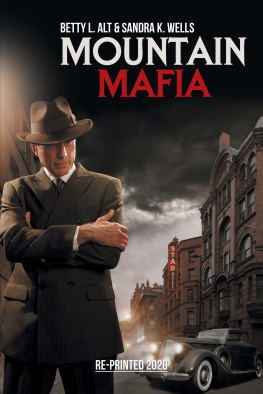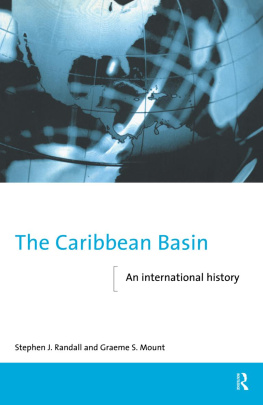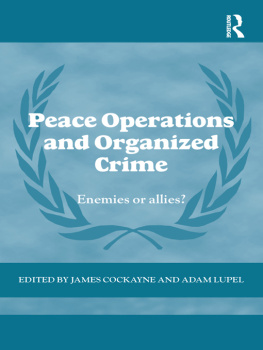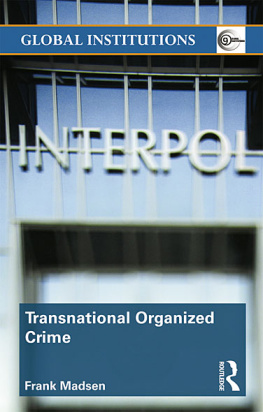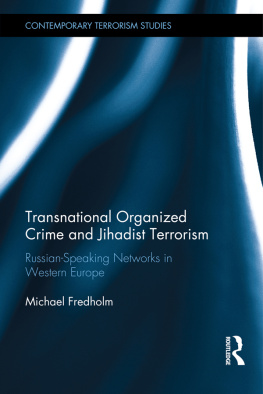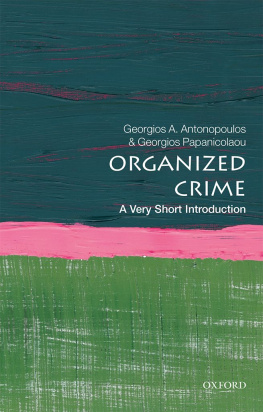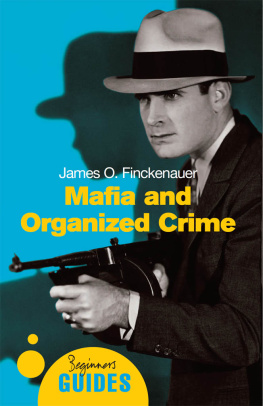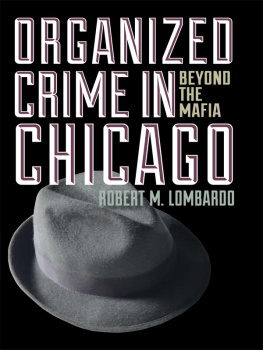
An Economic History of Organized Crime
Organized crime is a growing international phenomenon and, as it intersects with terrorism, an increasingly dangerous force. Organized crime has been studied from the perspectives of many scholarly disciplines, and there is a massive literature on the topic created by academics, journalists, government officials, and the criminals themselves. Surprisingly, while economists and historians have written about organized crime, there is no international economic history on the subject. There is a compelling need for such a book. More organized crime groups are emerging, they are coming from more countries, and the activities of all organizations are diversifying across national borders.
This book is a comparative study of organized crime groups from five different parts of the world: Europe; North America; Central America/South America/ Caribbean basin; Africa; and Asia/Western Pacific. Each part contains two case studies and a shorter essay, a vignette. From Europe the case studies focus on the Italian mafias and the Russian mafia; the vignette, on the Albanian mafia. From North America the case studies highlight the US mafia and the Mexican drug cartels; the vignette, organized crime in Canada. From Central America/South America/Caribbean basin the case studies concentrate on the Colombian drug cartels and gangs of the Caribbean; the vignette, on organized crime in Cuba. From Africa the case studies examine resource wars and Somali piracy; the vignette, relations among international drugs trafficking, organized crime, and terrorism in North and West Africa. And from Asia/Western Pacific the case studies spotlight the Chinese triads and Japanese yakuza; the vignette, relations among international drugs trafficking, organized crime, and terrorism in Afghanistan.
Written in non-specialist language, An Economic History of Organized Crime provides an original overview of a crucial problem of our times: the growing scourge of global organized crime. This book can be read with profit by the general public, but it also has value for academic specialists and professionals in law enforcement.
Dennis M. P. McCarthy is an Associate Professor Emeritus of History, Iowa State University, Ames, USA.
Routledge studies in crime and economics
Edited by Peter Reuter
University of Maryland, USA
and
Ernesto U. Savona
University of Trento, Italy
1 Political Economy of Illegal Drugs
Pierre Kopp
2 Deterrence and Crime Prevention
Reconsidering the prospect of sanction
David M. Kennedy
3 The Anti Money Laundering Complex and the Compliance Industry
Antoinette Verhage
4 An Economic History of Organized Crime
Dennis M. P. McCarthy
An Economic History of Organized Crime
A National and Transnational Approach
Dennis M. P. McCarthy

First published 2011
by Routledge
2 Park Square, Milton Park, Abingdon, Oxon OX14 4RN
Simultaneously published in the USA and Canada
by Routledge
605 Third Avenue, New York, NY 10017
Routledge is an imprint of the Taylor & Francis Group, an informa business
2011 Dennis M. P. McCarthy.
The right of Dennis M. P. McCarthy to be identified as author of this work has been asserted by him in accordance with the Copyright, Designs and Patent Act 1988.
All rights reserved. No part of this book may be reprinted or reproduced or utilized in any form or by any electronic, mechanical, or other means, now known or hereafter invented, including photocopying and recording, or in any information storage or retrieval system, without permission in writing from the publishers.
Trademark notice: Product or corporate names may be trademarks or registered trademarks, and are used only for identification and explanation without intent to infringe.
British Library Cataloguing in Publication Data
A catalogue record for this book is available from the British Library
Library of Congress Cataloging in Publication Data
McCarthy, Dennis M. P., 1944
An economic history of organized crime : a national and transnational approach / Dennis M.P. McCarthy.
p. cm.
Includes bibliographical references.
1.Organized crimeHistory. 2. MafiaHistory. 3. Transnational crime History. 4. CrimeEconomic aspects. I. Title.
HV6441.M293 2011
364.106dc22
2010050461
ISBN: 978-0-415-48796-2 (hbk)
ISBN: 978-0-203-81425-3 (ebk)
DOI: 10.4324/9780203814253
Typeset in Times
by Wearset Ltd, Boldon, Tyne and Wear
Charles J. McCarthy, Esq.
19192006
Firmus maneo.
I remain steadfast.
Preface
Two intellectual forces are responsible for the creation of this book. The first is my strong interest in organized crime, which dates back to my elementary and high school days in Cleveland, Ohio, USA, during the 1950s and early 1960s. A thrilling television series, The Untouchables, which aired from 19591963, enthralled me; it recounted, in an appropriately embellished manner, the feats of a group of US Treasury agents called The Untouchables during the Prohibition era in Chicago, Illinois, against the Chicago syndicate of Alphonse Al Capone, Jake Guzik, and Frank Nitti (see Chapter 5). Eliot Ness (19031957) led The Untouchables and I greatly admired him, but I must admit that the clipped narration of Walter Winchell and the driving theme by Nelson Riddle made it easy for me to be inspired. A defining moment in nurturing my interest in organized crime came during a trip with my father to see one of the numerous baseball and football games we attended together at the old Cleveland Municipal Stadium on the shores of Lake Erie. On one of those occasions, as we were driving west on the Shoreway towards the stadium in downtown Cleveland, a billboard high above the railroad tracks on the south side of the highway caught my eye, not the newer front of the billboard but a faded sign that still clung to the back. This sign proclaimed, Ness for Mayor. Is that the same Ness who worked in Chicago, I wondered. Yes, it was. In my first serious research on organized crime I learned that Eliot Ness resigned as a federal agent in 1935 and became the Safety Director for the City of Cleveland (19351942). He also ran, unsuccessfully, against Tom Burke for mayor of Cleveland in 1947. The second primal force pushing this book to completion is my intense interest is economic history, which became my all-time favorite academic subject when I took my first college course in it. It was the convergence of these two strong interests that has brought forth An Economic History of Organized Crime: A National and Transnational Approach.
I present this work not as a textbook but as a case studies book. And it is a case studies book designed to give readers a global overview of a global scourge: organized crime. Its organizational grid is based on the one I developed for my International Business History: A Contextual and Case Approach (Praeger, 1994). This grid divides the world into five geographical sections: Europe, North America, Central America/South America/the Caribbean, Africa, and Asia/the Western Pacific. Each section contains two case studies and a vignette; an introduction to each section defines main themes and relates the case studies and vignette to them. For my organized crime book I have added something new: for every case study and vignette I set the stage, providing background material that will help readers better understand the subject of the case study or vignette. I am keenly aware from experience with my business history book that not everyone will agree with my conception of what is the appropriate balance between breadth and depth, between coverage and selectivity in my organized crime book. Some will prefer fewer case studies developed in more detail; others will question my choices. This is understandable:
Next page


